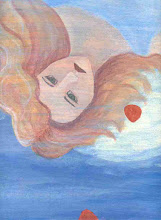Book 205: Many Moons, by James Thurber, illustrated by Marc Simont, Harcourt Books 1990.
The first time I encountered Many Moons by James Thurber, it was read to me. I was in third grade. If the illustrations were shown, I didn't see them. And they weren't necessary for me to enjoy the book -- I could picture it perfectly in my head. The story stayed with me for many years. If I ever knew, I soon forgot the name of the author. I've since forgotten the name of my third-grade teacher. But I've never forgotten how much I loved this book.
Years later, in my early twenties, I began reading Dorothy Parker. Which led to reading Robert Benchley. Which led to reading James Thurber. Thurber quickly became one of my favorite authors. But still I did not realize he wrote Many Moons. Not until about ten years later, when I was browsing in a bookstore, and I stumbled upon Many Moons. The version I found then was illustrated by Louis Slobodkin, which was good, but a bit manic and not quite as I remembered the book. Still, I bought the book. And read the book. And enjoyed the book.
A few years after that I was working as a children's librarian. In our department, we had been turning classical literature into puppet shows with quite a bit of success. I decided that Many Moons would be a great choice, so I pulled the book off of the shelf to type up a screenplay. The book on our shelf wasn't the Slobodkin version, though, it was the Marc Simont version, and the illustrations almost perfectly matched the illustrations I had carried in my head for thirty years. I was delighted. And the puppet show, by the way, was delightful.
Marc Simont passed away recently. He was 97, so his passing was sad but not surprising. Although he has illustrated many books, including other stories for Thurber, whenever I see any reference to him, I always think of this book, his Many Moons.









